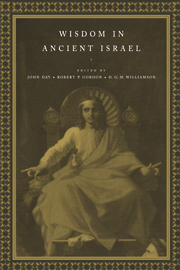Book contents
- Frontmatter
- Contents
- List of abbreviations
- Introduction
- Part 1 The ancient near eastern setting
- 1 Egyptian wisdom literature
- 2 Some new Babylonian wisdom literature
- 3 The Wisdom of Ahiqar
- Part 2 Old Testament and Apocryphal texts
- Part 3 Themes
- Biographical note: John Adney Emerton
- Bibliography of the works of John Adney Emerton
- Indexes
- Principal biblical and apocryphal references
3 - The Wisdom of Ahiqar
Published online by Cambridge University Press: 16 October 2009
- Frontmatter
- Contents
- List of abbreviations
- Introduction
- Part 1 The ancient near eastern setting
- 1 Egyptian wisdom literature
- 2 Some new Babylonian wisdom literature
- 3 The Wisdom of Ahiqar
- Part 2 Old Testament and Apocryphal texts
- Part 3 Themes
- Biographical note: John Adney Emerton
- Bibliography of the works of John Adney Emerton
- Indexes
- Principal biblical and apocryphal references
Summary
The figure of Ahiqar has remained a source of interest to scholars in a variety of fields. The search for the real Ahiqar, the acclaimed wise scribe who served as chief counsellor to Sennacherib and Esarhaddon, was a scholarly preoccupation for many years. He had a sort of independent existence since he was known from a series of texts – the earliest being the Aramaic text from Elephantine, followed by the book of Tobit, known from the Apocrypha, and the later Syriac, Armenian and Arabic texts of Ahiqar. An actual royal counsellor and high court official who had been removed from his position and later returned to it remains unknown. E. Reiner found the theme of the ‘disgrace and rehabilitation of a minister’ combined with that of the ‘ungrateful nephew’ in the ‘Bilingual Proverbs’, and saw this as a sort of parallel to the Ahiqar story. She also emphasized that in Mesopotamia the ummânu was not only a learned man or craftsman but was also a high official. At the time that Reiner noted the existence of this theme in Babylonian wisdom literature, Ahiqar achieved a degree of reality with the discovery in Uruk, in the excavations of winter 1959/60, of a Late Babylonian tablet (W20030,7) dated to the 147th year of the Seleucid era (= 165 BCE). This tablet contains a list of antediluvian kings and their sages (apkallû) and postdiluvian kings and their scholars (ummânu). The postdiluvian kings run from Gilgamesh to Esarhaddon.
- Type
- Chapter
- Information
- Wisdom in Ancient Israel , pp. 43 - 52Publisher: Cambridge University PressPrint publication year: 1995
- 1
- Cited by

